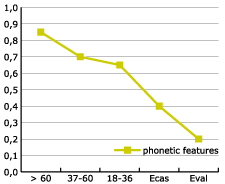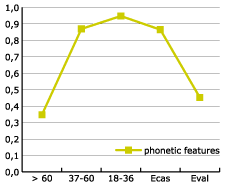
| Phonetic variation and standardisation in the Valencian Country, by Carles Segura Llopes | ||||
| CONTINUA |
Much of the phonetic detail looked at in this article remain below the threshold of consciousness for the speakers concerned, and are therefore far from easy to modify. These ongoing changes are not in general the result of conscious decisions or corrections but rather result from quite involuntary imitation of prestigious pronunciation, where there is Spanish influence. Typical instances are the raising (or closing) of o and e, Yeism, betacism, devoicing of voiced s and, above, the syntactic phonetics, aspiration of s before [k] or plosive b stops going to fricatives. As can be seen, these are standard features that belong to the traditional model, which, as we have seen, is in decline. Another factor to be noted is that most of these features are not indicated by the spelling. It is clear that Eval —schooling in Catalan— in the city of Elx, has not succeeded in redressing phonetic features of this sort. As we mentioned above, this fact disproves of our initial hypotheses in the sense that we expected all Eval students to show less Spanish influence in their phonology and make greater use of standard Catalan features where these coincide with the traditional model. The sociolinguistic situation of the Elx schoolchildren who are following an Eval curriculum results in more heavily Spanish-influenced phonology than found in the other group. This context stops conscious correction of the school sort from being very efficient if carried out on these phonetic traits, given that in general the latter have been heavily influenced by Spanish. In localities where Catalan is more present in the social life of the lads and lasses, Eval is more effective in the conserving (and restoring) of traits of this sort. But there is a second group of features that are more identifiable and, while they fall within the scope of phonetics, can be modified and restored —and even commented upon by the speakers themselves. Such features include the disappearance of intervocalic d or of final -r, to give two paradigmatic examples. There are others, however, such as halting the trend o deletion of –t in molt, the eliminating of the palatal in moixca, the reintroduction of the semivowel in caixa, the reintroduction of the a for e in embut. In some of these instances, these are elisions, which tends to make them more perceptible than the sounded phonemes. As such, they are more easy to restore, consciously. Moreover, support from spelling is more obvious than in the previous set of cases, and there is, finally, some overlap or parallelism with the phonetic forms of Spanish. This second group of phonetic features —mostly innovations— are more under the conscious control of the speaker —largely because of the spelling— and, therefore, are corrected by all individuals who have been educated in Catalan, whether in Elx or elsewhere. In such cases, Eval (schooling in Catalan) is after all more efficient in introducing them into the language model of the schoolchildren. In sum, our initial hypothesis has been only partly corroborated. The phonetic level is undergoing profound changes. In general, the normative or standard model would seem to be having little effect on this. There is a clear trend towards dilution of the traditional model, aided and abetted by intense influence from Spanish, at least in the formal register, as in the context created by administering of the questionnaires. The phonetic features, then, are undergoing a seemingly unstoppable degradation affecting particularly features below conscious level. One can only be relatively hopeful about the corrective influence provided by Eval for two reasons. In the first place because the percentage of school pupils following an Eval curriculum is very small, in all the Valencian Country, compared to Lval; secondly, if the environment of the individual is very heavily Spanish-influenced, the latter exercises excessive pressure on many features of the phonetic subsystem which Eval is not capable of redressing. Eval is relatively efficient only in the case of students who make frequent or high use of their own language. These latter also retain the traditional phonology better, closer to the standard model. Carles
Segura Llopes |

